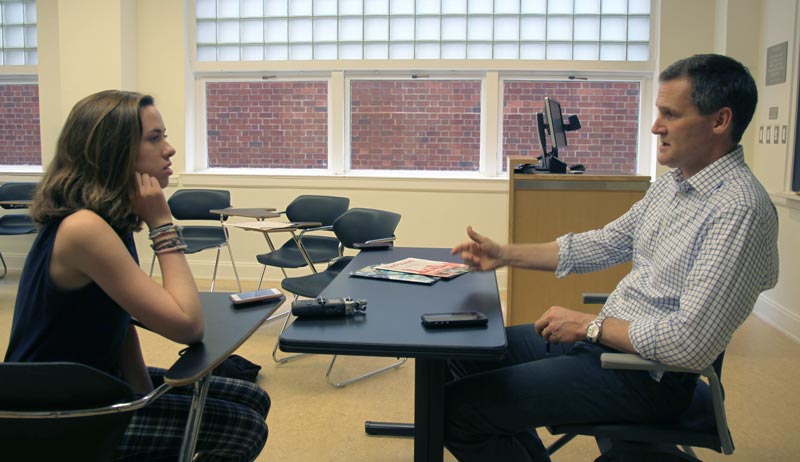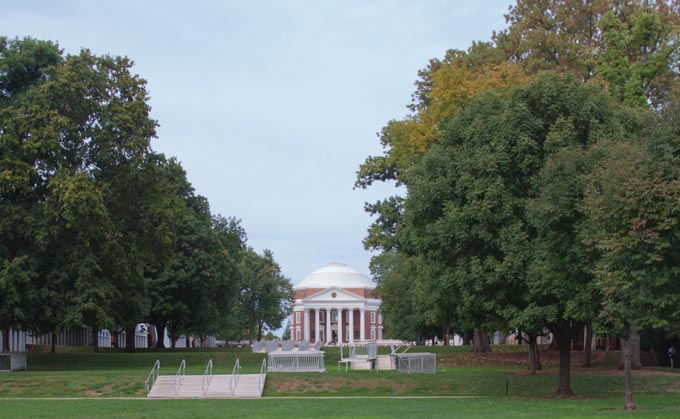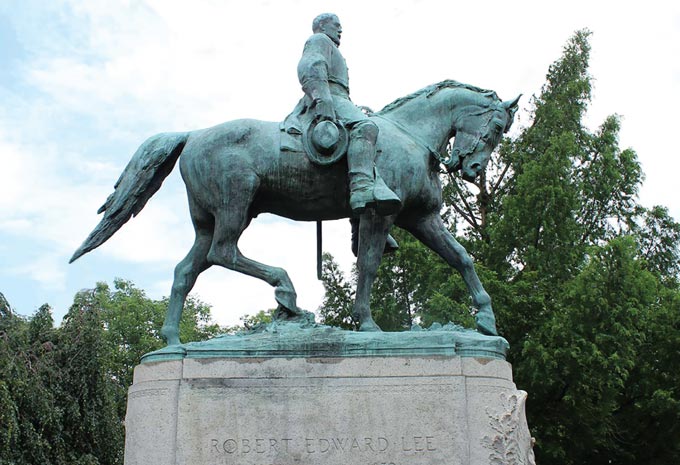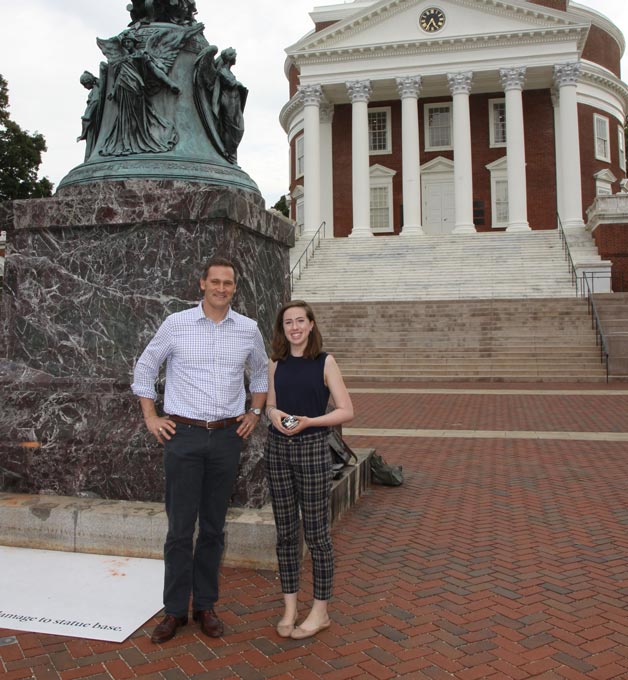FEATURE INTERVIEW - October, 2017
An Interview with Mayor Mike Signer and Tim Dodsen, Editor of The Cavalier Daily
By C.C. Clark, Senior, University High School
Color and light overwhelmed my vision; I wasn’t sure what I was hearing or what to look at—so I used my sixth sense to experience the moment on a more incomprehensible, spiritual level. There was static in the downtown air, and a buzz of energy, and passion. Storefronts welcomed in customers with Pride flags, posters reading “no home for hate here”, printouts with the name “Heather” inside a heart and other affirmations. University students, sparkling and charged with the excitement of life, raced down a brick-lined pathway, laughing and dragging each other along to the next activity. Live music, coming from the annual Tom Tom Founders Festival in Emancipation Park, pulsated into the downtown area, present but not overpowering the woman singing and playing her guitar on a nearby bench. No matter which way you turned, people were having a good time and enjoying each other’s company; people from all around the world, from all sorts of diverse backgrounds, coming together and welcoming you into this unique, present environment. In that moment, it was difficult to comprehend that a little over a month ago, at this exact spot in the downtown area of Charlottesville, Virginia, white nationalists and neo-Nazis were congregating, wielding torches and assault rifles, attacking counter protesters and hollering horrific phrases such as “You will not replace us” and “blood and soil.” These despicable actions were the antithesis of what I was observing this happy, inclusive evening. And yet it happened. Why and how it happened: that was what I was there to find out and analyze.
The events that took place in Charlottesville on the 11th and 12th of August were not the first (recent) acts of white-supremacist aggression to take place in the city. There had been a Ku Klux Klan rally earlier in the year; the city knew about it ahead of time and granted the KKK a permit to march since it was their constitutional right to do so. Later, in May, an event mirroring this one occurred, only this time it was a group of torch-wielding white supremacists gathered spontaneously without being granted a permit.
Around this time, tensions continued to rise in Charlottesville, as the debate raged regarding the presence of statues and monuments honoring Confederate leaders slowly became central to the city’s political discourse. Many people wanted the statues taken down, believing they venerated historical figures whose pro-slavery values were both abhorrent and treasonous. Others wanted to keep the statues where they were because of their political significance, to serve as a reminder of the (supposed) progress we’ve made as a country since the Civil War. Still others wanted to keep the statues but in a recontextualized state, with plaques explaining the historical significance in the context of the war, white supremacy and the institution of slavery. Others wanted to save the statues for the sick sense of pride. Though the city council ultimately voted to remove the statues, the decision is still pending in court; most likely, a decision will be reached in the near future.

That decision is what first inspired members of the alt-right to hold a march in Charlottesville. In an interview with FastForward in a classroom at the University of Virginia (where he had just taught a class on leadership, statesmanship, and democracy), Mayor Michael Signer explained to me that on the Monday prior to the Unite the Right Rally on August 12th, the city had announced that it would only grant a permit if the rally took place, not downtown, but in a less urban setting, preferably McIntire Park a little over a mile away. As a result of this decision, the city was sued on First Amendment grounds, and the Friday night before the rally a federal judge ruled that the rally could take place wherever its organizers wanted. Signer was at an interfaith community event with guest speaker Cornel West when he was informed of the court’s decision.
After hearing all this, I was interested in hearing about the events that took place on the 11th and 12th from somebody who has been present throughout everything that had occurred. I was able to contact and set up an interview at the campus of UVA with Tim Dodson, who, a third-year student at the University of Virginia, is the managing editor of the school’s student newspaper, The Cavalier Daily. As we walked through the campus, he showed me the exact path that had been taken by the white nationalists had taken on their protest march the night before the rally, and let me know what it was like to observe this terrifying demonstration as a student and journalist. A few hundred white nationalists started out at a field entitled Nameless Field, where they lit their torches; that very act seemed to mirror what had happened earlier that summer at the unplanned white supremacist rally lead by Richard Spencer. Once they were prepared, they began to march towards the lawn of UVA in an organized fashion that was quite militia-like, all the while shouting hateful phrases. Dodson recalled that when observing this, there was a scene of utter chaos and anarchy.
The following day was even worse. The rally was supposed to begin at noon, but the white nationalists and the counter-protesters arrived downtown hours beforehand. “It was very eerie,” Dodson recalled. “We went downtown, and I saw this group of what appeared to be officers in riot gear. In retrospect, I don’t think those were officers; it was difficult at points to tell who were official members of the law enforcement and who were white nationalists in military gear.” Brawls broke out everywhere; people carried firearms, acting as though they were prepared to shoot at any moment; tear gas and pepper spray could be sensed in the air. Eventually, unlawful assembly was declared, and the Unite the Right organizers decided at this point to move to McIntire Park, where the city had wanted the rally to take place originally. There was no police presence at this point, and as David Duke and Richard Spencer addressed members of the alt-right gathered at the park, even more verbal and physical fighting broke out. It was at this time, as well, that a Nazi sympathizer James Fields rammed his car into a group of counter-protesters, injuring many and tragically killing one person: Heather Heyer. Several lawsuits have since been filed against Unite the Right rally organizer Jason Kessler, the drivers, and the various white supremacist groups that were present that day.
When asked what inspired him to deliver such strong and impactful rhetoric when he addressed the press after the horrific events of the 12th, Signer’s answer was as certain, straightforward, powerful and heartfelt as his speeches: “I really believe in democracy. I really believe in this system of government and I am totally committed to these underlying values that have got us this far, like tolerance and pluralism and deliberation and compromise and listening. So it’s really important to stand up for those values when you have people who basically would set fire to them, which is what these people coming here are trying to do. And I take personal offense at their mission to intimidate us and bully us and frighten us and terrorize us. So I guess my response to this has been that we need to stand up for the values and the system that have gotten us 200 years into American democracy, and that this is a very good place to do it because we’re a very tolerant, diverse, welcoming, loving city that has a lot of the core ideas that help America thrive. We’re very religiously tolerant here. We believe in cultural diversity. We believe in freedom of speech. We believe in the idea that you can be whatever you want to be, whoever you want to be. Those are very Charlottesville ideas. So I guess I derive some of my strength and being so forceful about those from living here and from spending time in this community that believes those ideas so strongly.”
This idea of strengthening democracy has been a prominent part of Signer’s personal mission ever since he was in college, where he first became involved in government and political activism. While earning his Ph.D. at U.C. Berkeley, Signer studied and wrote about demagogues and “when democracies falter and self-destruct through people who prey on our prejudices.” As he delved more deeply into this subject, he began to notice that American history is filled to the brim with demagogues, from the times of the Federalist Papers, to the present day. Asked if he believes President Donald Trump is a demagogue, his answer was resolute: “I’ve spoken many time about how I really regret his choice to go to the absolute bottom of the gutter with playing into people’s prejudices…through the campaign, through the presidency. I think you see it in so much of the bullying tactics. You see it in how inflammatory a lot of the rhetoric is. You see it in the framing of so many public policies as extreme rhetorical options as opposed to serious outcomes of deliberation and legislation…So I think it’s done a lot of damage to our democracy.” Signer believes that Trump’s use of demagoguery to gain power has invited the alt-right into the mainstream, especially during his presidential campaign. “I think it’s been terrible for the country.”
 But every negative has a positive, as Signer realized when he studied true statesmanship and leadership, especially as exemplified by founding father James Madison (Signer wrote a well-regarded biography of the fourth president, Becoming Madison: The Extraordinary Origins of the Least Likely Founding Father”). In his opinion, strong leaders are essential to a well-functioning democracy. Says Signer: “You need people who are challenging public opinion, who are trying to be statesmanlike, who are trying to educate the public and who are taking unpopular positions and who are doing things for the common good rather than for themselves.” I couldn’t help but notice that this statement rang true for Signer himself, as he so ably demonstrated when the city of Charlottesville needed him. As for the emergence of the alt-right into American politics, Signer sees it as a test to the strength of democracy. While the test may be painful and oftentimes terrifying, it will, with time, make democracy stronger than it was before. As Signer said, “If you have a resilient, healthy democracy that is kind of awake, and where the norms that have gotten us so far are thriving, then we can overcome virtually anything.”
But every negative has a positive, as Signer realized when he studied true statesmanship and leadership, especially as exemplified by founding father James Madison (Signer wrote a well-regarded biography of the fourth president, Becoming Madison: The Extraordinary Origins of the Least Likely Founding Father”). In his opinion, strong leaders are essential to a well-functioning democracy. Says Signer: “You need people who are challenging public opinion, who are trying to be statesmanlike, who are trying to educate the public and who are taking unpopular positions and who are doing things for the common good rather than for themselves.” I couldn’t help but notice that this statement rang true for Signer himself, as he so ably demonstrated when the city of Charlottesville needed him. As for the emergence of the alt-right into American politics, Signer sees it as a test to the strength of democracy. While the test may be painful and oftentimes terrifying, it will, with time, make democracy stronger than it was before. As Signer said, “If you have a resilient, healthy democracy that is kind of awake, and where the norms that have gotten us so far are thriving, then we can overcome virtually anything.”
Charlottesville has taken steps to combat the legacy of last summer. The university’s Black Student Alliance (BSA) has made demands that if implemented will help distance the city even more from its slave-owning legacy. Several of these demands have in fact already been met; for example, several plaques honoring Confederate figures have been removed from campus. Legal efforts to remove Confederate monuments from the town are still underway. In addition, many organizations and people, like Charlene Greene and Paola Salas of the Charlottesville Human Rights Commission (Office of Human Rights), have been working for justice and equality in Charlottesville since long before the events of the 11th and 12th. Their primary role is to uphold a city ordinance that protects the human rights of specific segments of the community.
When looking at the events that took place in Charlottesville, it important for us to not view what has happened as something distant and alien, or as a faraway tragedy that occurred in a place far different from our own. The city is, in the words of Mayor Signer, “an incredibly loving, tolerant, and progressive community.” Tim Dodson is concerned that the city is known now for last summer’s violence instead of for its dynamic and thriving character. “People are like, ‘After Charlottesville, Trump said xyz,’ or ‘After Charlottesville, other cities in the country took down Confederate monuments.’ So ‘Charlottesville’ is in a lot of ways associated with what happened on August 11th and 12th. So that’s also been a sad aspect of this situation.” This discreditation of Charlottesville for its association with one terrible event doesn’t give the place credit for being the lively, liberal, and forward-thinking college town it is.
With all that being said, the town is by no means perfect; like anyplace, it has room for improvement. As Dodson reflected, “There are legacies of white supremacy in Charlottesville. So to say that this has been a community that has been free of racism, or free of discrimination, would be false,” said Dodson. “The question has been coming up a lot, is this Charlottesville? Obviously, we’re sitting on the steps of the rotunda of a university that was built by slaves. So white supremacy has been in Charlottesville since white people arrived.” Signer has also been grappling with how to have the city confront its history of racism and what actions to take based on understanding that history. When asked what his vision for the future of Charlottesville is, he responded, “My vision is that we react to this [alt-right] invasion by becoming even better at those practices that made us a target in the first place [deciding to remove Confederate statues, etc.]. I think we should not be intimidated from that really important work of being a progressive city, dealing with the past, dealing with our future, trying to become more equitable, more fair and more tolerant.”
 One way Signer has personally done this is his recent change of heart regarding the statues. Before the events of last summer, he believed that they should not be taken down and that we should instead focus on explaining their historical context and adding new monuments to current values and past injustices. After the attacks, though, he came to believe that the meaning behind the statues had changed dramatically—they were no longer objects of historical significance, they were simply magnets attracting acts of terrorism. He mentioned that this fundamental shift in his views all came together during the memorial service for Heather Heyer, when her mother asked for everybody to amplify her voice through their actions. In this moment, the answer suddenly became clear to him.
One way Signer has personally done this is his recent change of heart regarding the statues. Before the events of last summer, he believed that they should not be taken down and that we should instead focus on explaining their historical context and adding new monuments to current values and past injustices. After the attacks, though, he came to believe that the meaning behind the statues had changed dramatically—they were no longer objects of historical significance, they were simply magnets attracting acts of terrorism. He mentioned that this fundamental shift in his views all came together during the memorial service for Heather Heyer, when her mother asked for everybody to amplify her voice through their actions. In this moment, the answer suddenly became clear to him.
When asked what advice he’d give to youth around the country, Signer said that it’s very important that young people know and understand the roots of the United States and the core aspects of our political philosophy. He emphasizes that since this is the country that we as a generation are going to inherit, it’s important to study and reflect upon our heritage so we can become active and engaged citizens of this democracy. He explained, “If you give up on all that stuff or you’re disengaged, then it means that the powers of cynicism and terrorism will just move into the void and you’ll have a country that you’re not proud of.” He cautions us to be wary of the lies and emotional manipulations rampant in social media, and that if we demand better from social media—less character assassination and “fake news” and more actual substance—it will get better. “Every debate doesn't fit into 140 characters.”
If there’s one thing that I truly came to understand during my reporting assignment in Charlottesville, it is that we as human beings view history as a series of disconnected events floating around in a distant, far-off past. We see current events as far-away occurrences that have no effect on our own lives. Neither of these views are, of course, true. History isn’t a crazy quilt of separate events; it’s a continuum. The world we live in today is the result of centuries of complex and interconnected developments that have affected every corner of the globe. In this sense, the events that took place in Charlottesville on the 11th and 12th were merely another battle of the Civil War and World War II. While both wars ended officially with treaties and other paperwork, the battle of ideologies they represented never died; and lately these battles (slave versus free; fascism versus democracy) have become newly inflamed. It’s also important to understand that Charlottesville is a sister to our own town. If the events of the 11th and 12th had taken place in the Bay Area, they would feel much more real to us. So it’s important that when events like this happen, we learn everything we can about them and reach out to the people who’ve experienced them; shared human experience is what unites us against the forces of intolerance. We must call upon ourselves to stand up to injustice in whichever spheres we are a part of and whenever we observe it taking place. For, as Signer reflected, “I’ve been likening [the events of the 11th and 12th] to a hurricane that came here,” said Signer. “You deal with a hurricane by building levees that contain and protect cities. That’s what keeps the floodwaters behind. The levees are built by hundreds of people putting sandbags together and building a wall to protect it.” If we all come together to build a levee, with resilience and an understanding of one another’s individual experiences, we can stand up to intolerance and prejudice, and perhaps, with time, the United States of America will become the country that its founders meant for it to become for the first time in its history.
